C语言运算符重载
悲伤土豆拌饭 人气:0写一个Add函数
我们先讨论下面代码,并复习前面的内容
class Complex
{
private:
double Real, Image;
public:
Complex() :Real(0), Image(0) {}
Complex(double r, double i) :Real(r), Image(i) {}
~Complex() {}
//Complex Add(const Complex* const this,const Complex &c)
Complex Add(const Complex& x)const
{
Complex y;
y.Real = Real + x.Real;
y.Image = Image + x.Image;
return y;
//return Complex(this->Real + x.Real, this->Image + x.Image);
}
void Print()
{
cout << Real << "+" << Image << "i" << endl;
}
};
int main()
{
Complex c1(12, 23);
Complex c2(4.5, 5.6);
Complex c3;
c3 = c1.Add(c2);
c3.Print();
return 0;
}

直接return可以使用无名函数直接代替将亡值对象,相比可以省一次对象的构建
我们再分析如果我们使用引用返回Add函数
const Complex& Add(const Complex& x)const
{
Complex y;
y.Real = Real + x.Real;
y.Image = Image + x.Image;
return y;
//return Complex(this->Real + x.Real, this->Image + x.Image);
}
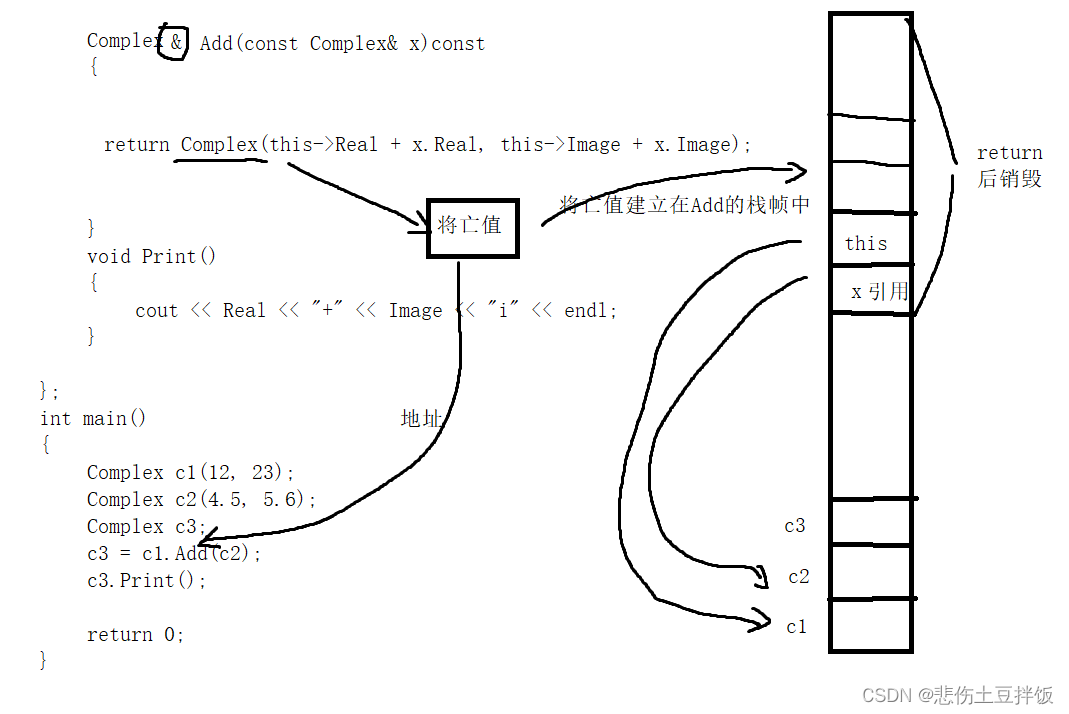
若我们以引用返回,将亡值对象会创建在Add函数的栈帧中,然后返回将亡值地址,函数return结束该空间会被释放、
若没有引用,构建无名对象也就是将亡值对象会构建在主函数的空间中,这里使用将亡值对象值给到c3是没有问题的
我们查看对象的构造与析构
class Complex
{
private:
double Real, Image;
public:
Complex() :Real(0), Image(0) {}
Complex(double r, double i) :Real(r), Image(i)
{
cout << "Create:" << this << endl;
}
Complex(const Complex& x):Real(x.Real),Image(x.Image)
{
cout << "Copy Create:" << this << endl;
}
~Complex()
{
cout << "~Complex:" << this << endl;
}
//Complex Add(const Complex* const this,const Complex &c)
Complex Add(const Complex& x)const
{
return Complex(this->Real + x.Real, this->Image + x.Image);
}
void Print()
{
cout << Real << "+" << Image << "i" << endl;
}
};
int main()
{
Complex c1(12, 23);
Complex c2(4.5, 5.6);
Complex c3;
c3 = c1.Add(c2);
c3.Print();
return 0;
}

首先我们使用引用返回需要加上const修饰,这是因为我们返回将亡值在临时空间具有常性,所以普通引用是不能进行返回的,需要使用常引用返回
const Complex& Add(const Complex& x)const
{
return Complex(this->Real + x.Real, this->Image + x.Image);
}
我们发现对临时对象的构建后马上就进行析构,那么是怎么将数据拿出给到c3的?这个在最后我们进行分析
为什么不用加号作为函数名
//Complex operator+(const Complex* const this,const Complex &c)
Complex operator+(const Complex &c) const
{
return Complex(this->Real + x.Real, this->Image + x.Image);
}
这里是不可以的,加号是一个操作符,不能使用操作放作为有效的函数名称;但是在C++中为了使这些操作符号能够当作函数名,那么我们需要在前面加上一个关键字operator
//Complex operator+(const Complex* const this,const Complex &c)
Complex operator+(const Complex &c) const
{
return Complex(this->Real + x.Real, this->Image + x.Image);
}
也就是告诉编译器,加号是一个有效的函数名,这就叫做运算符的重载;随后我们之间使用 c3 = c1 + c2 就是可以的
int main()
{
Complex c1(12, 23);
Complex c2(4.5, 5.6);
Complex c3;
c3 = c1 + c2;
//编译器编译会是下面的情况
//c3 = c1.operator+(c2);
//c3 = operator+(&c1,c2); 加上this指针
}
运算符的重载
一个对象,编译器会给它有6个缺省函数
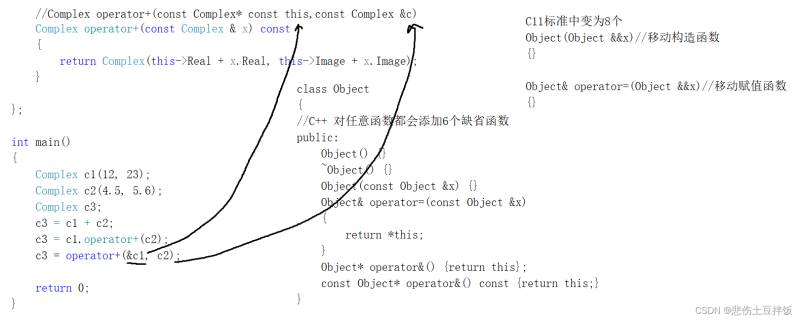
我们再来看下面这个问题
//我们写一个赋值运算符重载
void operator=(const Object& obj)
{
this->value = obj.value;
}
//返回类型为void,这样不可以就不可以连等
//obja = objb = objc;
//obja = objb.operator=(objc);
//obja = operator=(&objb,objc); 返回的无类型,不能给obja赋值
且赋值函数不可以定义为const修饰
Object& operator=(const Object& obj)
{
this->value = obj.value;
return *this;
}
obja = objb = objc; //改写 obja = objb.operator=(objc); obja = operator=(&objb,objc); obja.operator=(operator=(&objb,objc)); operator=(&obja,operator=(&objb,objc));
通过返回对象,就可以实现连等;并且我们可以通过引用返回,因为此对象的生存期并不受函数的影响,不会产生一个临时对象作为一个过度
防止自赋值
若是我们将obja给obja赋值,也就是自赋值
obja = obja operator=(&obja,obja);
我们就需要进行一步判断
Object& operator=(const Object& obj)
{
if(this != &obj)//防止自赋值
{
this->value = obj.value;
}
return *this;
}
上面问题解决
我们通过这段代码来看,与上面问题相同
Object& operator=(const Object& obj)
{
if (this != &obj)
{
this->value = obj.value;
}
return *this;
}
};
Object& fun(const Object& obj)
{
int val = obj.Value() + 10;
Object obja(val);
return obja;
}
int main()
{
Object objx(0);
Object objy(0);
objy = fun(objx);
cout << objy.Value() << endl;
return 0;
}
我们在这里希望通过引用返回,这里return的临时对象会构建在fun函数的栈帧中,并且在函数结束栈帧释放,随后调用赋值运算符重载,但是数值依旧是正确的
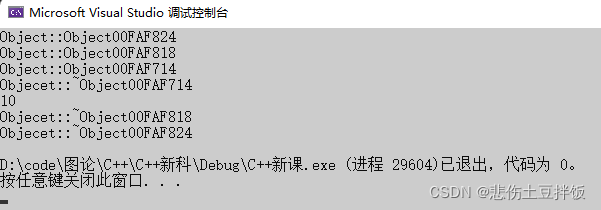
我们跟踪这个被析构对象的地址,首先我们定位在fun函数的return obja;,随后进入析构函数将我们的obja进行析构

接着运行到回到主函数进行赋值,接着进入赋值运算符重载,可以看到,这里的obj地址与已被析构的obja地址相同

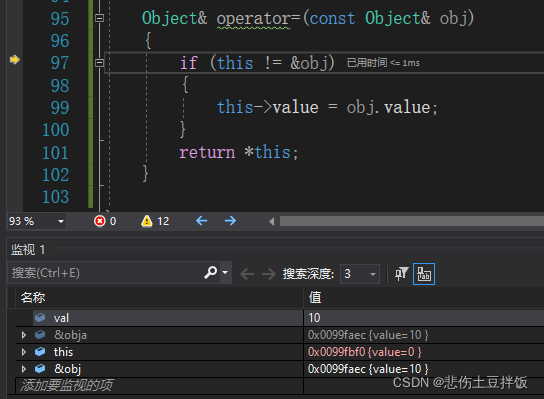
可以看到这个值依旧存在,依旧可以打印给出,这是因为vs2019的特殊性质造成的;我们每次运行程序会发现每次的对象地址都在变化,逻辑地址会随机改变,被析构对象的栈帧不会被接下来的赋值运算符重载扰乱地址空间,所以即使我们引用返回的对象已经死亡依旧可以将数值正确返回
但是在vc中,我们得到的值会是随机值,这是因为vc中每次运行程序地址都不会改变,当我们从fun函数退出进入赋值语句中,就会将原本存储数据的地址扰乱,继而变成了随机值
尽管我们引用返回能够将数据正确打印,但是该对象已经死亡,这是不安全的,所以我们一定不要以引用返回对象
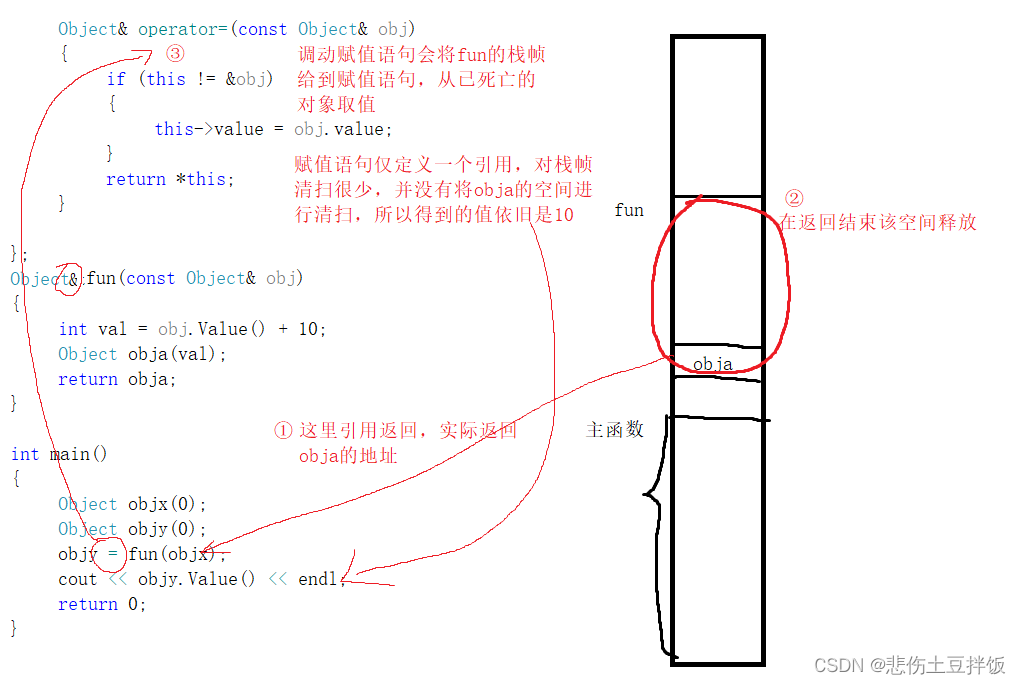
VS2019具有一个特点:当我们调用函数,若函数中没有定义局部变量或局部对象时,该函数基本不对栈帧进行清扫
总结
加载全部内容